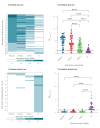Highly pathogenic avian influenza (HPAI) H5 virus exposure in domestic cats and rural stray cats, the Netherlands, October 2020 to June 2023
- PMID: 39484684
- PMCID: PMC11528901
- DOI: 10.2807/1560-7917.ES.2024.29.44.2400326
Highly pathogenic avian influenza (HPAI) H5 virus exposure in domestic cats and rural stray cats, the Netherlands, October 2020 to June 2023
Abstract
BackgroundHighly pathogenic avian influenza (HPAI) H5Nx and human H1N1pdm2009 influenza viruses can infect cats. Infections in cats may result in viral adaptations or recombinant viruses, which may facilitate zoonotic transfer.AimWe aimed to investigate the presence of HPAI H5 clade 2.3.4.4 and H1 influenza viruses and antibodies to these viruses in domestic and rural stray cats in the Netherlands and factors associated with exposure.MethodsSera from stray and domestic cats, sampled 2020-2023, were analysed by ELISA and confirmed by hemagglutination inhibition assay (HAI) and pharyngeal swabs and lung tissue for influenza A virus by RT-qPCR.ResultsIn 701 stray cats, 83 (11.8%; 95% confidence interval (CI): 9.5-14.5) sera were positive for HPAI H5 and 65 findings were confirmed. In HAI, two sera were positive for both HPAI H5 and H1. In 871 domestic cats, four (0.46%; 95% CI: 0.13-1.2) sera were HPAI H5 positive and none were confirmed but 40 (4.6%; 95% CI: 3.3-6.2) sera were seropositive for H1 and 26 were confirmed. Stray cats living in nature reserves (odds ratio (OR) = 5.4; 95% CI: 1.5-20.1) and older cats (OR = 3.8; 95% CI: 2.7-7.1) were more likely to be HPAI H5 seropositive. No influenza A virus was detected in 230 cats.ConclusionThe higher HPAI H5 seroprevalence in stray cats compared with domestic cats suggests more frequent viral exposure, most likely due to foraging on wild birds. In contrast, exposure to H1 was more common in domestic cats compared with stray cats.
Keywords: Serosurveillance; avian influenza; pandemic preparedness; zoonosis.
Conflict of interest statement
Figures


References
-
- The World Organisation for Animal Health (WOAH). OIE terrestrial manual 2021. Avian influenza (including infection with high pathogenicity avian influenza viruses). Paris: WOAH; May 2021. Available from: https://www.woah.org/en/what-we-do/standards/codes-and-manuals/terrestri...
-
- Food and Agriculture Organization of the United Nations (FAO). Ongoing avian influenza outbreaks in animals pose risk to humans. Rome: FAO; 12 Jul 2023. Available from: https://www.fao.org/animal-health/news-events/news/detail/ongoing-avian-...
-
- Bordes L, Vreman S, Heutink R, Roose M, Venema S, Pritz-Verschuren SBE, et al. Highly pathogenic avian influenza H5N1 virus infections in wild red foxes (Vulpes vulpes) show neurotropism and adaptive virus mutations. Microbiol Spectr. 2023;11(1):e0286722. 10.1128/spectrum.02867-22 - DOI - PMC - PubMed
MeSH terms
Substances
LinkOut - more resources
Full Text Sources
Miscellaneous
